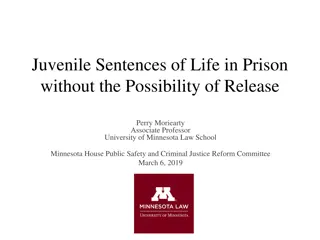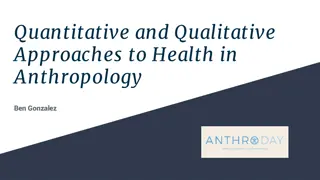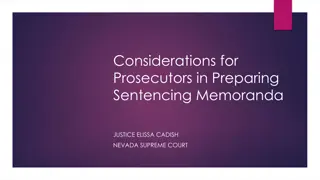Latest Updates in Criminal Law 2023: Key Cases and Sentencing Considerations
Explore the significant developments in criminal law for 2023, covering key cases involving intensive corrections orders, sentencing discounts for guilty pleas, evidence in psychiatric reports, relevance of personality disorders in sentencing, and more. Delve into the nuances of legal decisions shap
0 views • 13 slides
Addressing Oral Health Disparities in School Communities
This resource highlights the importance of improving pediatric oral health outcomes in schools through community partnerships. It discusses the existing disparities, barriers to accessing dental care, and the impact of oral health on educational outcomes. The learning outcomes include identifying di
2 views • 19 slides
Recent Developments in Commonwealth Offenders Sentencing and Mandatory Minimums
Explore recent sentencing developments for Commonwealth offenders in Australia including mandatory minimum sentences in specific offenses. Learn how to navigate Commonwealth sentencing laws, utilize helpful resources, and understand exceptions to mandatory terms of imprisonment for certain specified
0 views • 34 slides
Alabama Sentencing Commission
This detailed report covers the Alabama prison population from the 1980s to 2023, highlighting fluctuations and legislative interventions. It discusses the factors affecting prison population size and the impact of sentencing standards and reinvestment legislation. The visuals provided depict the pr
0 views • 27 slides
Understanding Sentencing Practices and Primary Custody in Legal System
This educational presentation by the U.S. Sentencing Commission Office covers essential concepts such as primary custody, concurrent vs. consecutive sentences, and determining the applicability of departures and variances in sentencing. It also discusses a scenario involving multiple sentences for a
1 views • 31 slides
Understanding Health Disparities and Equity in Behavioral Health Care
This module explores the significance of health disparities, health equity, and social justice within integrated behavioral health care. It delves into the role of addressing disparities, promotes ways to achieve equity in care models, and discusses the key organizations dealing with health disparit
0 views • 28 slides
Impact of Oregon's Drug Decriminalization on Sentencing Guidelines: Analysis from 2022 NASC Conference
Recent changes in Oregon's drug laws have led to significant reductions in arrests and convictions related to possession of controlled substances. These changes include shifting many drug offenses from felonies to misdemeanors, resulting in a drastic decrease in arrests and convictions since the imp
1 views • 19 slides
U.S. Sentencing Commission Case Law Update
Explore recent Supreme Court decisions, Eighth Circuit rulings, and legal principles related to the Armed Career Criminal Act and specific cases like Wooden vs. United States. Learn about sentencing procedures, supervised release, and factors determining the classification of offenses in this inform
0 views • 30 slides
Understanding Health Disparities and Medicaid's Role in Advancing Equity
Health and health care disparities refer to differences in health outcomes and access to care among different groups, often linked to social, economic, and environmental inequities. People of color face longstanding disparities in health and health care, with factors inside and outside the health ca
5 views • 16 slides
Health and Health Care Disparities for Black Americans in the United States
Analysis of health and health care disparities for Black Americans in the US reveals significant challenges, including underrepresentation, economic disparities, and health outcome gaps. Despite improvements in some health measures, such as HIV diagnosis rates and teen birth rates, Black Americans s
5 views • 9 slides
Sentencing Strategies for Child Pornography Cases: Insights & Recommendations
Exploring sentencing strategies for child pornography cases, this resource delves into guidelines, departures/variances, restitution, and conditions of supervised release. It also discusses the offender profile, changes in penalty ranges, and average sentences. The content highlights how sentences h
0 views • 40 slides
Examining Legal Issues in Capital Sentencing
This content discusses aggravating and mitigating circumstances in criminal acts, along with cases like Ring v. Arizona and Hurst v. Florida, focusing on the Sixth Amendment rights and the role of the jury in determining death penalty sentencing. The cases highlight the importance of jury findings a
0 views • 13 slides
Military Justice Sentencing Update for COL Tyesha Smith
Military Justice sentencing update for COL Tyesha Smith covers the process where the accused selects sentencing authority, with options ranging from no sentence to maximum available. Separate sentences for each offense may be determined to run concurrently or consecutively. The FY22 NDAA parameters
0 views • 5 slides
Understanding the Place of Parole: A Review of Sentencing and the Penal System
Exploring the role of parole within the context of sentencing and the penal system, this review delves into themes of justice, risk assessment, rehabilitation programs, victim involvement, offender perspectives, public perceptions, and challenges faced by community supervisors. The discussion touche
1 views • 9 slides
Addressing Discipline Disparities in School Systems
Systemic disparities in school discipline pose critical short- and long-term consequences for students, schools, communities, and economies. Efforts to address these disparities include recent national initiatives, federal guidance, and collaborative research projects aiming to improve interventions
1 views • 7 slides
Criminal Justice Sentencing and Drug Policies in Baumgartner's POLI 203 Course
Announcements include upcoming guest speakers and reminders. Discussions cover motivated reasoning, victim focus versus defendant focus, and appropriate sentences for various crimes. The historical forms of sentencing in the US are explored, along with drug sentencing policies in Portugal post-dicta
0 views • 8 slides
Clermont County Community Alternative Sentencing Center 2019 Annual Report
The Clermont County Community Alternative Sentencing Center's annual report for the calendar year 2019 highlights services offered, including substance use disorder treatment, group counseling, individual counseling, case management, and more. The report also includes a sample program schedule detai
0 views • 9 slides
Juvenile Sentencing Hearings and Legislative Responses: Legal Overview
Explore key cases like Roper v. Simmons, Graham v. Florida, and Miller v. Alabama that shaped juvenile sentencing laws. Delve into legislative responses like Chap. 2014-220, Laws of Florida, focusing on individualized hearings and factors considered in sentencing. Discover the impact on juvenile off
0 views • 104 slides
Sentencing Criteria in Moldova's Criminal Justice System
Covering the sentencing criteria, prison population statistics, legal framework, general and special criteria, issues in judicial practice, the role of the Supreme Court of Justice, and sentencing guidelines in Moldova's criminal justice system.
0 views • 10 slides
Understanding Sentencing in the Criminal Justice System
Exploring the complexities of sentencing in the criminal justice system, this content delves into the principles of sentencing, the role of courts in determining sentences, restrictions on sentencing by magistrates and judges, maximum and minimum sentences, and the aims and effectiveness of the sent
0 views • 25 slides
Addressing Health Disparities in People with Intellectual Disabilities: Roles of Nurses and Midwives
People with intellectual disabilities face significant health disparities, including multiple long-term health conditions and higher mortality rates. Nurses and midwives play diverse roles in addressing these disparities through research and inclusive practices. Common conditions include epilepsy, o
0 views • 20 slides
Understanding the Impact of the Criminal and Traffic Assessment Act
The Criminal and Traffic Assessment Act (705 ILCS 135) impacts legal practice by consolidating fines, defining assessments, creating uniformity, providing sentencing options, and allowing for fee waivers. Financial sentencing components include fines, assessments, service provider costs, restitution
0 views • 40 slides
Changes Introduced by the First Step Act of 2018
The First Step Act, enacted in December 2018, brought significant changes such as the expansion of safety valve, retroactive application of the Fair Sentencing Act of 2010, and initiatives to reduce recidivism and imprisonment. Sections like 402, 403, and 404 address safety valve broadening, clarifi
0 views • 27 slides
Juvenile Sentencing Laws: Updates and Legislative Schemes Across States
The information provided discusses juvenile sentencing laws, emphasizing life imprisonment without parole and the changes being made at the state level. It covers amendments required after Miller v. Alabama, states that have not made changes, states that have banned juvenile life sentences without r
0 views • 6 slides
Addressing Disparities in School Discipline: Understanding Implicit Bias and Cultural Competence
This content delves into the intricate issues surrounding implicit bias and cultural competence in school discipline, focusing on disparities related to race, disability, gender, gender identity, and sexual orientation. It discusses the factors contributing to disproportionate disciplinary actions,
0 views • 5 slides
Legal Measures and Sentencing in Washington State
This content provides an overview of various legal measures and sentencing practices in Washington State, including the treatment of persistent offenders, initiatives such as I-593, the role of the Washington State Constitution in approving laws, and the implementation of laws related to second-degr
0 views • 15 slides
Analysis of Sentencing Guidelines for Felonies and Homicide in North Carolina
Explore North Carolina's sentencing guidelines for felonies and different types of homicide, including punishments for crimes such as first-degree murder, manslaughter, and assault. Delve into a ranking exercise to assess which crimes may be perceived as most deserving of the death penalty based on
0 views • 14 slides
Illinois Sentencing Policy Advisory Council Meeting Insights
Insights from the Illinois Sentencing Policy Advisory Council's September 17, 2021 meeting include discussions on recidivism costs, fiscal impacts, demographic breakdowns of admissions to IDOC, and analysis of repeat gun offenders' criminal history. The presentation covers data on offenders, non-pro
0 views • 15 slides
Understanding Health Disparities in Late Life by Roland J. Thorpe, Jr., PhD
The presentation by Roland J. Thorpe, Jr., PhD focuses on health disparities in late life, highlighting projections of the resident population by race/ethnicity, the expected increase in the older U.S. population from 1990 to 2050, and percentages of males and females aged 65 and over with disabilit
0 views • 11 slides
Understanding Racial and Ethnic Income Disparities
This piece delves into the income and wealth gaps among different racial and ethnic groups, emphasizing the importance of framing when analyzing such disparities. It presents data from the Federal Reserve's Survey of Consumer Finances, highlighting the slower closure of income gaps for Black and His
0 views • 16 slides
Sentencing Guidelines Overview for Kansas City, MO - FY 2014
The presentation provides insights into sentencing trends in Kansas City, focusing on departures and variances in relation to the guideline range for the fiscal year 2014. Data from the 2014 Sourcebook of Federal Sentencing Statistics is utilized to analyze the position of sentences for non-governme
0 views • 10 slides
Understanding Sentencing of Young Offenders
Explore the judicial processes and options available for sentencing young offenders, focusing on rehabilitation and reformation. Learn about the age of criminal responsibility, types of sentences, and considerations under the Criminal Justice and Immigration Act 2008. Discover the effectiveness of r
0 views • 21 slides
Overview of Adult Sentencing in Criminal Justice
Adult sentencing in criminal justice involves four main categories of sentences available to the court: custodial sentences, community sentences, fines, and discharges. Custodial sentences for adults can range from weekend prison to life imprisonment, with mandatory life sentences for certain seriou
0 views • 21 slides
Understanding Adult Sentencing and Custodial Sentences
Adult sentencing involves 4 main categories of sentences: Custodial sentences (including mandatory life sentences), Community sentences, Fines, and Discharges. Custodial sentences for adult offenders can vary in duration from weekend prison to whole life imprisonment, with some offenses mandating a
0 views • 24 slides
Patterns in Domestic Violence Order Breach Sentencing Outcomes
Explore the patterns in sentencing outcomes for breaches of domestic violence orders over time, legislative and community contexts, key findings, and current study results in the field of criminology at Griffith University.
0 views • 19 slides
Approaches to Health Disparities in Anthropology: Quantitative vs. Qualitative Methods
Exploring health in anthropology involves various factors like social, cultural, biological, and linguistic influences. This content delves into the quantitative research on disparities in health insurance coverage, particularly focusing on Latino vs. white respondents in Texas. The study utilized l
0 views • 13 slides
Comparative Perspectives on Sentencing and Rehabilitation in Criminal Justice Systems
Exploring the historical context and current practices in sentencing and rehabilitation within criminal justice systems, the discussion covers topics such as the evolving forms of sentencing in the US, the impact of drug sentencing in Portugal, disparities in punishment among different countries, pr
0 views • 11 slides
Key Considerations for Prosecutors in Sentencing Procedures
Understanding sentencing memoranda, unique statutes, and the responsibilities related to mentally ill defendants, prosecutors must factor in crime details, criminal history, victim impact, mitigating factors, and additional penalties. The court's discretion in imposing deadly weapon enhancements and
0 views • 9 slides
Insights from the 2017 Applied Research in Crime and Justice Conference
This conference delved into the preferences and disparities between jurors and judges in sentencing outcomes in Victoria, Australia. Researchers examined whether jurors tend to be more lenient or severe compared to judges, the impact of crime types on juror decisions, and the correlation between sen
0 views • 34 slides
Understanding Federal Sentencing Principles
Federal sentencing is determined by various factors including the applicable sentencing statute, statutory maximum and minimum terms of imprisonment, fines, supervised release terms, special assessments, the U.S. Sentencing Commission Guidelines Manual, judicial discretion, and factors outlined in 1
0 views • 26 slides







































